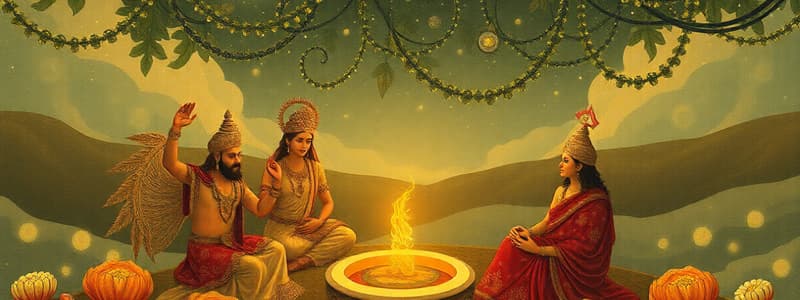Podcast
Questions and Answers
Explain the concept of Nishkamakarma as presented in the Bhagavad Gita and provide a real-world example of how this principle can be applied in daily life.
Explain the concept of Nishkamakarma as presented in the Bhagavad Gita and provide a real-world example of how this principle can be applied in daily life.
Nishkamakarma is the performance of action without attachment to results or selfish motives. For example, volunteering time at a homeless shelter without expecting anything in return exemplifies Nishkamakarma.
Compare and contrast Advaita Vedanta and Visistadvaita Vedanta in terms of their understanding of the relationship between Brahman and Atman.
Compare and contrast Advaita Vedanta and Visistadvaita Vedanta in terms of their understanding of the relationship between Brahman and Atman.
Advaita Vedanta posits the non-dual identity of Brahman and Atman, while Visistadvaita Vedanta suggests that Atman is a part of Brahman but retains distinct qualities.
Briefly discuss the significance of Prasthanathraya in Indian philosophical tradition. What texts constitute it, and why are they important?
Briefly discuss the significance of Prasthanathraya in Indian philosophical tradition. What texts constitute it, and why are they important?
Prasthanathraya is a collection of three important texts in Vedanta philosophy. They are the Upanishads, the Brahma Sutras, and the Bhagavad Gita. They form the foundational texts for interpreting Vedanta.
Explain Plato's Theory of the Forms. How does Plato use this theory to describe the difference between knowledge and opinion?
Explain Plato's Theory of the Forms. How does Plato use this theory to describe the difference between knowledge and opinion?
Describe Kant's concept of the 'categorical imperative' and provide an example of how it might be applied to a contemporary ethical dilemma.
Describe Kant's concept of the 'categorical imperative' and provide an example of how it might be applied to a contemporary ethical dilemma.
Flashcards
Prasthanatrayi
Prasthanatrayi
Three foundational texts of Vedanta philosophy: the Upanishads, the Brahma Sutras, and the Bhagavad Gita.
Nishkamakarma
Nishkamakarma
Selfless action performed without attachment to results, as taught in the Bhagavad Gita.
Stitaprajna
Stitaprajna
One who has achieved a state of unwavering wisdom and equanimity, undisturbed by joys or sorrows.
Nyaya Philosophy
Nyaya Philosophy
Signup and view all the flashcards
Cardinal Virtues
Cardinal Virtues
Signup and view all the flashcards
Study Notes
- The learning philosophy involves specific norms that guide the educational process.
- Philosophy has several utilities that enhance critical thinking, reasoning, and a deeper understanding of various aspects of life.
Prasthanathraya
- Prasthanathraya consists of the three authoritative texts of Vedanta philosophy.
- The three texts are the Upanishads, the Brahma Sutras, and the Bhagavad Gita.
Vedas, Upanishads, Brahman, Atman
- Vedas are the ancient scriptures that form the foundation of Hindu philosophy.
- Upanishads explore philosophical concepts such as Brahman (the ultimate reality) and Atman (the individual self).
- Brahman is the ultimate reality, the source of everything in existence.
- Atman is the individual self or soul, which is believed to be a part of Brahman.
Bhagavad Gita - Nishkamakarma
- Bhagavad Gita introduces Nishkamakarma, the concept of selfless action.
- Nishkamakarma teaches performing actions without attachment to the results.
Yoga
- Bhakti Yoga emphasizes devotion and love towards a personal god.
- Karma Yoga focuses on performing one's duties with detachment.
- Jnana Yoga stresses the pursuit of knowledge and wisdom to achieve liberation.
Stitapranja
- Stitapranja refers to a person of steady wisdom.
- A Stitapranja is unperturbed by dualities like pleasure and pain.
Brahmasutra
- Brahmasutra is a collection of concise statements summarizing the teachings of the Upanishads.
Indian Philosophy
Nyaya
- Nyaya's theory of knowledge emphasizes the importance of valid cognition.
- Valid cognition which is achieved through perception and inference.
- Perception is a direct and immediate form of knowledge.
Key Schools
- Sankhya, Yoga, Advaita Vedanta, Dvaita Vedanta, and Visistadvaita Vedanta are key schools of Indian philosophy.
Thinkers
- Prominent Indian thinkers include:
- Mahatma Gandhi.
- Swami Vivekananda.
- Thinkers from Kerala.
Greek Philosophy
- Key figures in Greek philosophy
- Pythagoras.
- Thales.
- Aristotle.
- Plato.
- Socrates.
Rationalism
- Rationalism emphasizes reason as the primary source of knowledge.
Empiricism
- Empiricism asserts that sensory experience is the primary source of knowledge.
Key Figures
- Immanuel Kant.
- Hegel.
- Karl Marx.
Phenomenological Method
- The phenomenological method focuses on describing the structure of experience as it presents itself to consciousness.
Existentialism
- Existentialism emphasizes individual freedom, choice, and responsibility.
Logical Positivism
- Logical positivism asserts that only statements verifiable through empirical evidence are meaningful.
Pragmatism
- Pragmatism evaluates the truth of beliefs based on their practical consequences.
Logical Atomism
- Logical atomism analyzes the logical structure of language and reality.
Linguistic Philosophy
- Linguistic philosophy examines philosophical problems through the study of language.
Character and Conduct
- Character and conduct are central to ethical considerations.
Theory of Punishment
- The theory of punishment explores justifications for penal measures.
Virtues - Plato's Cardinal Virtues
- Plato's cardinal virtues are wisdom, courage, temperance, and justice.
Ethics
- Professional ethics provides guidelines for conduct in specific professions.
- Cyber ethics deals with moral principles in the digital realm.
Studying That Suits You
Use AI to generate personalized quizzes and flashcards to suit your learning preferences.
Description
Explore Hindu philosophy with the Vedas, Upanishads, and Bhagavad Gita. Understand Brahman, Atman, and the concept of Nishkamakarma (selfless action). These texts enhance critical thinking and a deeper understanding of life.





